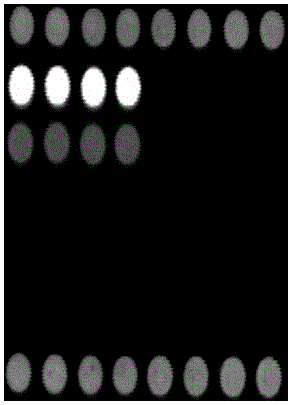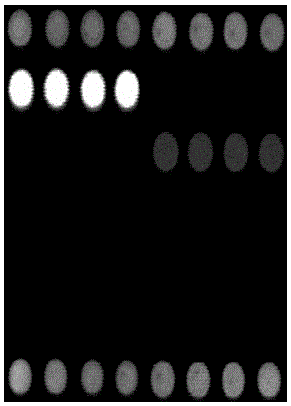Gene chip for identification of six swine disease pathogens and detection method thereof
A gene chip and pathogen technology, applied in the field of biochips, can solve the problem of lack of parallel detection of six pathogens, and achieve the effect of strong and stable hybridization signal, ensuring the safety and stability of animal husbandry.
- Summary
- Abstract
- Description
- Claims
- Application Information
AI Technical Summary
Problems solved by technology
Method used
Image
Examples
Embodiment 1
[0063] Embodiment 1, the present invention is to cultivate Actinobacillus pleuropneumoniae, Haemophilus parasuis and Mycoplasma hyopneumoniae respectively, and extract pathogen genomic DNA; porcine circovirus type 2, porcine reproductive and respiratory syndrome virus and swine fever virus cell proliferation to extract the virus genome. Cloning, sequencing and analysis of the specific conserved sequences of Actinobacillus pleuropneumoniae, Haemophilus parasuis, Mycoplasma hyopneumoniae, porcine circovirus type 2, porcine reproductive and respiratory syndrome virus and swine fever virus. Results Six oligonucleotide probes were designed, which can specifically bind to the PCR products of the corresponding pathogens. When PCR is used for genome amplification, the 5' end of the upstream universal primer is labeled with Cy3 fluorescent dye, and the probes can be combined with this product. Hybridization was performed at 42°C. According to the position and intensity of the fluoresc...
Embodiment 2
[0081] Example 2, see figure 1 , a gene chip for the detection of important pathogens of respiratory disease syndrome, using the micro-spotting technology of the gene chip, the sample probes to be tested and various quality control probes are fixed on the chemically modified substrate, forming 8 rows × 7 columns of microarrays. The distribution of probes on the microarray from top to bottom is: spot quality control partition P1: 1 row × 8 points, hybridization positive quality control partition P2: 1 row × 4 points, hybridization negative quality control partition N: 1 row × 4 points, Actinobacillus pleuropneumoniae detection probe partition 1: 1 row × 4 points, Haemophilus parasuis detection probe partition 2: 1 row × 4 points, Mycoplasma hyopneumoniae detection probe partition 3: 1 Row × 4 points, porcine circovirus type 2 detection probe partition 4: 1 row × 4 points, porcine reproductive and respiratory syndrome virus detection probe partition 5: 1 row × 4 points, swine f...
Embodiment 3
[0084] Example 3, reagent preparation
[0085] 1) Chip wash solution
[0086] According to the needs and actual situation, prepare washing liquid I and washing liquid II according to the following proportions.
[0087] Washing solution I: the final concentration of SSC is 2×, and the final concentration of SDS is 0.2%. For example, 600mL of washing solution I = 528mL of distilled water + 60mL of 20×SSC + 12mL of 10% SDS, or prepared in proportion as required.
[0088]Washing solution II: The final concentration of SSC is 0.2×. Such as 600mL lotion II = 594mL distilled water + 6mL 20×SSC, or prepare according to the needs.
[0089] If 10% SDS produces a white flocculent precipitate, please place it in a 42°C water bath to dissolve and mix, and then prepare a lotion.
[0090] 2) Absolute ethanol.
[0091] 3) Ice water mixture.
PUM
 Login to View More
Login to View More Abstract
Description
Claims
Application Information
 Login to View More
Login to View More - R&D Engineer
- R&D Manager
- IP Professional
- Industry Leading Data Capabilities
- Powerful AI technology
- Patent DNA Extraction
Browse by: Latest US Patents, China's latest patents, Technical Efficacy Thesaurus, Application Domain, Technology Topic, Popular Technical Reports.
© 2024 PatSnap. All rights reserved.Legal|Privacy policy|Modern Slavery Act Transparency Statement|Sitemap|About US| Contact US: help@patsnap.com










